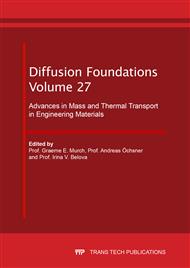[1]
S.J. Zhang, R. Xia, and R.T. Shrout, Lead-Free Piezoelectric Ceramics: Alternatives for PZT? J. Electroceram. 19 (2007) 251-257.
DOI: 10.1007/s10832-007-9056-z
Google Scholar
[2]
T. Takenaka, H. Nagata, and Y. Hiruma, Current developments and prospective of lead-free piezoelectric ceramics, Jpn. J. Appl. Phys. 47 (2008) 3787-3801.
DOI: 10.1143/jjap.47.3787
Google Scholar
[3]
P. K. Panda, Review: environmental friendly lead-free piezoelectric materials, J. Mater. Sci. 44 (2009) 5049-5062.
DOI: 10.1007/s10853-009-3643-0
Google Scholar
[4]
D. Damjanovich, N. Klein, J. Li and V. Porokhonskyy, What can be expected from lead-free piezoelectric materials?, Funct. Mater. Lett. 3 (2010) 5-13.
DOI: 10.1142/s1793604710000919
Google Scholar
[5]
D.Q. Xiao, Progresses and further considerations on the research of perovskite lead-free piezoelectric ceramics, J. Adv. Dielectr. 1 (2011) 33-40.
DOI: 10.1142/s2010135x11000045
Google Scholar
[6]
Y.Q. Lu and Y.X. Li, A Review on Lead-Free Piezoelectric Ceramics Studies in China, J. Adv. Dielectr. 1 (2011) 269-288.
Google Scholar
[7]
I. Coondoo, N. Panwar, A. Kholkin, Lead-free piezoelectrics: Current status and perspectives, J. Adv. Dielectr. 3 (2013) 1330002 (22 pages).
DOI: 10.1142/s2010135x13300028
Google Scholar
[8]
J.-F. Li, K. Wang, F.-Y. Zhu, L.-Q. Cheng, F.-Z. Yao, (K, Na)NbO3-Based Lead-Free Piezoceramics: Fundamental Aspects, Processing Technologies, and Remaining Challenges, J. Am. Ceram. Soc. 96 (2013) 3677-3696.
DOI: 10.1111/jace.12715
Google Scholar
[9]
J.G. Wu, D.Q. Xiao, J.G. Zhu, Potassium-sodium niobate lead-free piezoelectric materials: Past, present, and future of phase boundaries, Chem. Rev. 115 (2015) 2559-2595.
DOI: 10.1021/cr5006809
Google Scholar
[10]
P.K. Panda and B. Sahoo, PZT to Lead-Free Piezo Ceramics, Ferroelectrics 474 (2015) 128-143.
DOI: 10.1080/00150193.2015.997146
Google Scholar
[11]
C.H. Hong, H.P. Kim, B.Y. Choi, H.S. Han, J.S. Son, C.W. Ahn, W. Jo, Lead-free piezoceramics. Where to move on? J. Materiomics 2 (2016) 1-24.
DOI: 10.1016/j.jmat.2015.12.002
Google Scholar
[12]
Y.-J. Dai, X.-W. Zhang, and Ke-Pi Chen, Morphotropic phase boundary and electrical properties of K1−xNaxNbO3 lead-free ceramics, Appl. Phys. Lett. 94 (2009) 042905.
DOI: 10.1063/1.3076105
Google Scholar
[13]
H.-Y. Park, C.-W. Ahn, H.-C. Song, J.-H. Lee, and S. Nahma, Microstructure and piezoelectric properties of 0.95(Na0.5K0.5)NbO3–0.05BaTiO3 ceramics, App. Phys. Lett. 89 (2006) 062906.
DOI: 10.1063/1.2335816
Google Scholar
[14]
J. Fang, X. Wang, R. Zuo, Z. Tian, C. Zhong, L. Li, Narrow sintering temperature window for (K,Na)NbO3-based lead-free piezoceramics caused by compositional segregation, Phys. Status Solidi A. 208 (2011) 791-794.
DOI: 10.1002/pssa.201026500
Google Scholar
[15]
K. Wang, J.-F. Li, J. (K,Na)NbO3-based lead-free piezoceramics: Phase transition, sintering and property enhancement, Adv. Ceramics 1 (2012) 24-37.
DOI: 10.1007/s40145-012-0003-3
Google Scholar
[16]
R. Zuo, J. Roedel, R. Chen, L. Li, Sintering and electrical properties of lead-free Na0.5K0.5NbO3 piezoelectric ceramics, J. Am. Ceram. Soc. 89 (2006) 2010-2015.
Google Scholar
[17]
S. Zhang, R. Xia, T.R. Shrout, Modified (K0.5Na0.5)NbO3 based lead-free piezoelectrics with broad temperature usage range, Appl. Phys. Lett. 91 (2007) 132913.
DOI: 10.1063/1.2794400
Google Scholar
[18]
J. Tellier, B. Malič, B. Dkhil, D. Jenko, J. Cilensek, M. Kosec, Crystal structure and phase transitions of sodium potassium niobate perovskites, Solid State Sci. 11 (2009) 320-324.
DOI: 10.1016/j.solidstatesciences.2008.07.011
Google Scholar
[19]
B. Malič, J. Koruza, J. Hreščak, J. Bernard, K. Wang, J.G. Fisher, A. Benčan, Sintering of lead-free piezoelectric sodium potassium niobate ceramics, Materials 12, (2015) 8117-8146.
DOI: 10.3390/ma8125449
Google Scholar
[20]
E.D. Politova, G.M. Kaleva, N.V. Golubko, A.V. Mosunov, V.S. Akinfiev, S.Yu. Stefanovich, E.A. Fortalnova, Influence of NaCl/LiF Additives on Structure, Microstructure and Phase Transitions of (K0.5Na0.5)NbO3 Ceramics, Ferroelectrics 489 (2015) 147-155.
DOI: 10.1080/00150193.2015.1070248
Google Scholar
[21]
E.D. Politova, N.V. Golubko, G.M. Kaleva, A.V. Mosunov, N.V. Sadovskaya, S. Yu. Stefanovich, D.A. Kiselev, A.M. Kislyuk, P.K. Panda, Processing and characterization of lead-free ceramics on the base of sodium-potassium niobate, J. Adv. Diel. 8 (2018) 1850004.
DOI: 10.1142/s2010135x18500042
Google Scholar
[22]
M. E. Ringgaard and T.Wurlitzer, Lead-free piezoceramics based structure, microstructure and electrical properties of on alkali niobates, J. Eur . Ceram. Soc. 25 (2005) 2701-2706.
DOI: 10.1016/j.jeurceramsoc.2005.03.126
Google Scholar
[23]
E.D. Politova, D.A. Strebkov, D.A. Belkova, , G.M. Kaleva, N.V. Golubko, V. Mosunov, N.V. Sadovskaya, P.K. Panda, Relaxation Effects in Nonstoichiometric NBT-Based Ceramics, Defect and Diffusion Forum, 391 (2019) 95-100.
DOI: 10.4028/www.scientific.net/ddf.391.95
Google Scholar
[24]
E. D. Politova, N. V. Golubko, A. V. Mosunov, N. V. Sadovskaya, G. M. Kaleva, D. A. Kiselev & A. M. Kislyuk, Influence of additives on structure and ferroelectric properties of NBT-BT-BMT ceramics, Ferroelectrics, 531 (2018) 22-30.
DOI: 10.1080/00150193.2018.1497406
Google Scholar
[25]
V.V. Zhurov, S.A. Ivanov, PROFIT a program for powder diffraction data evaluation for IBM PC with a graphical user interface. Crystallography Reports, 42 (1997) 239-243.
Google Scholar
[26]
Dunmin Lin, K. W. Kwok, K. H. Lam, and H. L. W. Chan. Structure and electrical properties of K0.5Na0.5NbO3 –LiSbO3 lead-free piezoelectric ceramics. Journal of Applied Physics, 101 (2007) 074111.
DOI: 10.1063/1.2715486
Google Scholar
[27]
V.V. Shvartsman, D.C. Lupascu, Lead-Free Relaxor Ferroelectrics, J. Amer. Ceram. Soc. 95 (2012) 1-26.
DOI: 10.1111/j.1551-2916.2011.04952.x
Google Scholar
[28]
W. Kleemann, Random-field induced antiferromagnetic, ferroelectric and structural domain states, Int. J. Mod. Phys. B 7 (1993) 2469-2507.
DOI: 10.1142/s0217979293002912
Google Scholar
[29]
S. Jesse, A.P. Baddorf, S.V. Kalinin, Switching spectroscopy piezoresponse force microscopy of ferroelectric materials, Appl. Phys. Lett. 88 (2006) 062908.
DOI: 10.1063/1.2172216
Google Scholar
[30]
H. Trivedi, V.V. Shvartsman, D.C. Lupascu, M.S. Medeiros, R.C. Pullar, A.L. Kholkin, P. Zelenovskiy, A. Sosnovskikh, V.Y. Shur, Local manifestations of a static magnetoelectric effect in nanostructured BaTiO3–BaFe12O9 composite multiferroics, Nanoscale 7 (2015) 4489-4496.
DOI: 10.1039/c4nr05657d
Google Scholar


